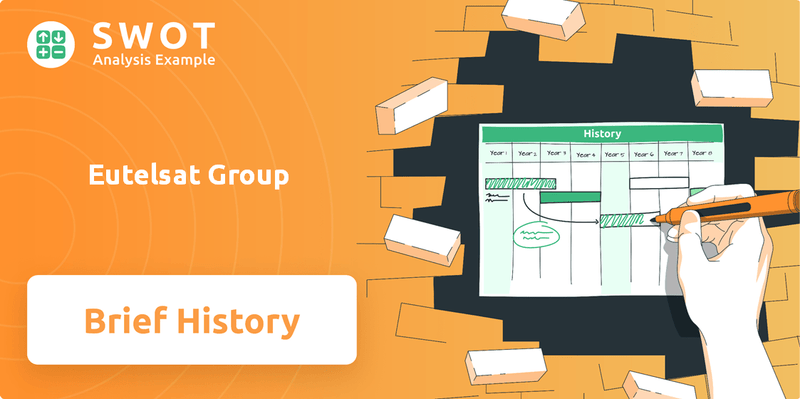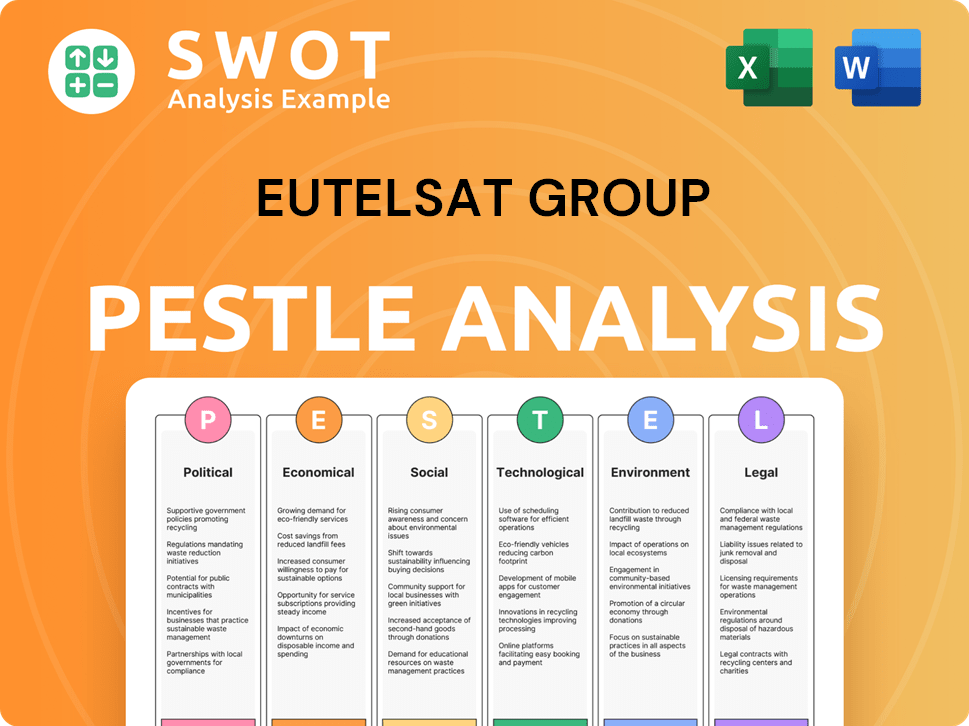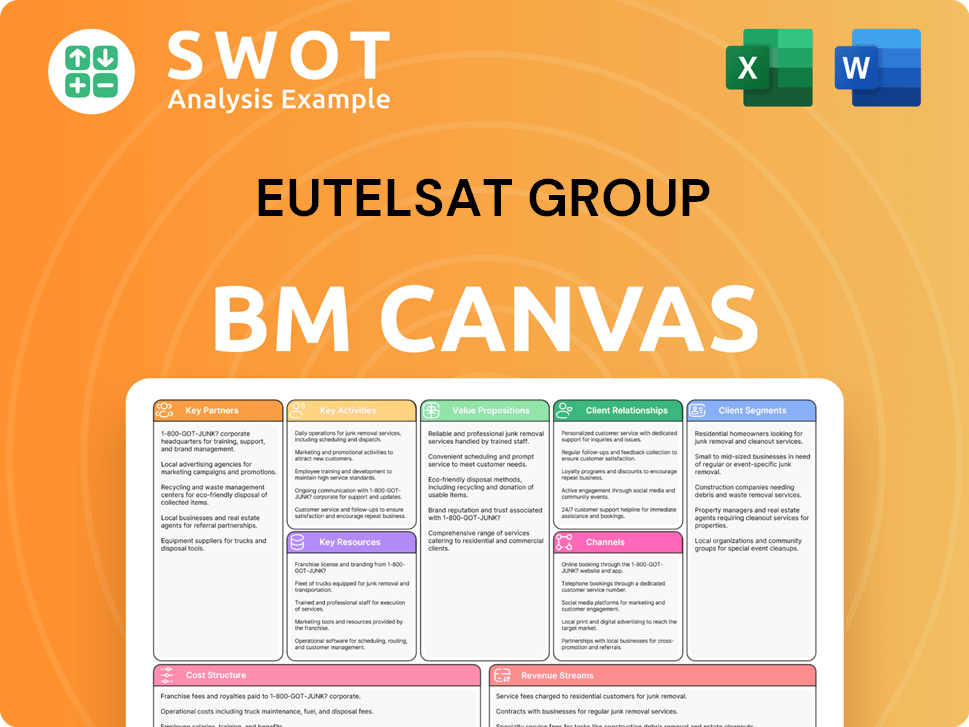Eutelsat Group Bundle
What's the Story Behind Eutelsat Group's Rise?
Ever wondered how a satellite company became a global force in the space industry? Eutelsat Group's journey is a fascinating tale of transformation, starting from its European roots. From its inception as an intergovernmental organization in 1977, Eutelsat has continuously adapted and expanded its reach.

Eutelsat's evolution from a European telecom initiative to a global satellite company is a testament to its strategic foresight. Today, Eutelsat Group is a major player, offering video, data, and government services worldwide. Understanding the Eutelsat Group SWOT Analysis can provide deeper insights into the company's strengths and future prospects, making it a crucial study for anyone interested in the space industry.
What is the Eutelsat Group Founding Story?
The story of Eutelsat Group, a prominent satellite company, begins with its provisional establishment in 1977. This initiative was spearheaded by 17 European countries, all members of the European Conference of Postal and Telecommunications Administrations (CEPT). The primary goal was to create and manage a satellite infrastructure to support telecommunications services across Europe.
The formal Convention that officially established Eutelsat came into effect on September 1, 1985. This followed the opening of the convention for signatures in July 1982. This marked a significant step in the company's journey, solidifying its role in the space industry.
Eutelsat's early business model focused on providing space segment capacity for essential telecommunications and audiovisual services. A pivotal moment occurred in 1983 with the launch of EUTELSAT I-F1, the first satellite. This launch initiated commercial satellite television broadcasting in Europe, enabling the transmission of the first commercial satellite TV signal. This allowed analogue channels to reach consumers who had early reception equipment.
Eutelsat's creation was driven by the ambition to build a European industry for satellite manufacturing, launching, and operation. The initial focus was on providing infrastructure for telecommunications and audiovisual services.
- The provisional establishment of Eutelsat in 1977 by 17 European countries.
- The formal Convention came into force on September 1, 1985.
- The launch of EUTELSAT I-F1 in 1983, marking the beginning of commercial satellite television.
- The establishment of the initial EUTELSAT I satellite fleet by 1988.
Following the initial launch, three more satellites in the EUTELSAT I series were launched, with the final one in 1988. This established the initial EUTELSAT I satellite fleet. The Growth Strategy of Eutelsat Group has evolved significantly since these early years, adapting to the changing demands of the telecom and space industry.
As of 2024, the satellite company continues to play a critical role in global communications. Eutelsat's history reflects a commitment to innovation and expansion, with its early foundations setting the stage for its future growth. The company's early milestones, including the launch of its first satellite, laid the groundwork for its ongoing contributions to the space industry and global connectivity.
Eutelsat Group SWOT Analysis
- Complete SWOT Breakdown
- Fully Customizable
- Editable in Excel & Word
- Professional Formatting
- Investor-Ready Format

What Drove the Early Growth of Eutelsat Group?
The early growth of the Eutelsat Group was marked by significant expansion, particularly after the fall of the Berlin Wall. This period saw the launch of new satellites, which increased capacity and broadened geographic reach, significantly impacting the satellite TV market. Eutelsat played a pioneering role in the transition to digital broadcasting, setting the stage for multi-channel pay-TV platforms across Europe. This expansion was crucial in establishing Eutelsat's position in the space industry.
In the mid-1990s, Eutelsat Group saw the first transmissions using the DVB-S standard. The HOTBIRD constellation, launched in 1995 at 13° East, became key to broadcasting hundreds of television channels. These channels reached millions of homes via cable networks and Direct-to-Home antennas. This period highlighted Eutelsat's contributions to communication and its role as a leading satellite company.
Eutelsat transitioned into a private company in July 2001 and went public in 2005. The 2000s saw Eutelsat's activities diversify to include internet and government services. The broadcast business continued to expand, with the HOTBIRD concept replicated at other orbital positions. This diversification was key to Eutelsat's financial performance over time.
Key technological advancements included the launch of HOTBIRD 13A in 2002, the first satellite with digital onboard multiplexing. In 2004, Eutelsat launched Europe's first HDTV demo channel and the first satellite with Lithium-Ion batteries. Geographic reach expanded across Africa, Asia, and the Americas, leading to the opening of offices globally. For more insights into the company's core values, check out Mission, Vision & Core Values of Eutelsat Group.
Eutelsat developed the DVB-SH standard for Direct Satellite Mobile Broadcasting between 2006 and 2008, and launched FRANSAT in 2009. In January 2014, Eutelsat acquired the Mexican company Satmex, which became Eutelsat Americas, further expanding its presence in the Americas. These strategic moves highlight Eutelsat's key milestones in the telecom sector.
Eutelsat Group PESTLE Analysis
- Covers All 6 PESTLE Categories
- No Research Needed – Save Hours of Work
- Built by Experts, Trusted by Consultants
- Instant Download, Ready to Use
- 100% Editable, Fully Customizable

What are the key Milestones in Eutelsat Group history?
The Eutelsat Group, a prominent player in the space industry, has a rich history marked by significant milestones. These achievements highlight its evolution and its impact on the telecom sector.
| Year | Milestone |
|---|---|
| 2019 | Development of the EUTELSAT QUANTUM satellite with the multibeam active antenna payload. |
| 2023 | Combination of Eutelsat and OneWeb, creating the first fully integrated GEO-LEO satellite operator. |
| 2023 | Shareholders approved the merger of Eutelsat and OneWeb, with over 87% voting in favor. |
| 2024 | Eutelsat participated in the European Union's IRIS² multi-orbit constellation project, investing €2 billion. |
Eutelsat Group has consistently pushed technological boundaries. A key innovation is the EUTELSAT QUANTUM satellite, which allows for in-orbit reconfiguration. This advancement enables flexibility in coverage, frequency, and power.
The EUTELSAT QUANTUM satellite, introduced in 2019, features a multibeam active antenna payload. This technology allows for unprecedented reconfigurability in orbit.
The merger with OneWeb in 2023 created the first fully integrated GEO-LEO satellite operator. This strategic move aimed to enhance connectivity services.
Eutelsat's involvement in the IRIS² project demonstrates its commitment to supporting Europe's sovereign space capabilities. The company invested €2 billion in this initiative.
Despite its achievements, Eutelsat faces challenges in the competitive satellite company landscape. The decline in the Video segment and overall revenue decrease pose significant hurdles.
The traditional Video segment, which accounts for approximately half of Eutelsat's revenues, is experiencing a structural decline. There was a 6.4% year-on-year decrease in Q3 2024-25.
Eutelsat's total revenues for Q3 2024-25 were down 1.9% on a like-for-like basis, reaching €300 million. This decline reflects the changing market dynamics.
The company reported a significant net loss of €873.2 million for the six months ending December 31, 2024. This substantial loss was primarily driven by a €535 million goodwill impairment.
Eutelsat's net debt stood at approximately €2.7 billion as of December 31, 2024, with a net debt to Adjusted EBITDA ratio of 3.92 times. This is a key area of focus for the company.
Eutelsat Group Business Model Canvas
- Complete 9-Block Business Model Canvas
- Effortlessly Communicate Your Business Strategy
- Investor-Ready BMC Format
- 100% Editable and Customizable
- Clear and Structured Layout

What is the Timeline of Key Events for Eutelsat Group?
The brief history of Eutelsat Group reflects a journey from an intergovernmental organization to a leading global satellite company. Key milestones have shaped its evolution, including pioneering satellite launches, strategic acquisitions, and transformative mergers. The company's adaptability and innovation have been crucial in navigating the competitive space industry and expanding its services.
| Year | Key Event |
|---|---|
| 1977 | Creation of Eutelsat as an intergovernmental organization. |
| 1983 | Launched the first satellite, EUTELSAT I-F1, marking the beginning of satellite television. |
| 1985 | The Convention establishing Eutelsat formally enters into force. |
| 1995 | Launched HOTBIRD 1, initiating the successful HOTBIRD constellation. |
| July 2001 | Eutelsat transforms into a private company. |
| 2005 | Eutelsat goes public. |
| 2014 | Acquisition of Satmex, expanding into the Americas as Eutelsat Americas. |
| 2019 | Presented the EUTELSAT QUANTUM satellite with its groundbreaking reconfigurable payload. |
| April 2021 | Eutelsat acquires a 24% stake in OneWeb. |
| July 2022 | Announcement of the merger between Eutelsat and OneWeb. |
| September 2023 | Completion of the Eutelsat and OneWeb merger, forming Eutelsat Group, the first integrated GEO-LEO operator. |
| October 2023 | KONNECT VHTS enters service, underpinning Fixed Connectivity revenue growth. |
| December 2024 | Eutelsat signs a €10.6 billion deal with the EU for the IRIS² satellite project, committing €2 billion. |
| February 2025 | Reports a net loss of €873.2 million for H1 FY2024-25 due to a €535 million goodwill impairment on GEO assets. Confirms full-year financial objectives for FY 2024-25, with gross capital expenditure now expected between €500-600 million. |
| May 2025 | Jean-François Fallacher is appointed as the new CEO, succeeding Eva Berneke. |
| May 2025 | Reports Q3 2024-25 revenues of €300.6 million, down 2.2% year-on-year, but nine-month revenues are up 1.8%. Connectivity segments represent 57% of the company's backlog, up from 55% a year ago. |
Eutelsat Group is strategically prioritizing the expansion of its connectivity business. This includes a strong emphasis on LEO-enabled solutions and investments in various connectivity verticals. The company aims to capitalize on growing demand for satellite broadband and connectivity services.
The company is targeting double-digit revenue and EBITDA CAGR over the medium to long term. It plans to leverage its robust cash flow to support expansion into the LEO market through OneWeb's next generation of satellites. The company's backlog shows that connectivity segments represent 57% of the company's backlog, up from 55% a year ago.
Eutelsat is seeking €1.5 billion in funding to expand its LEO constellations and replace retired satellites. Discussions are ongoing with existing investors, including the French and UK governments. Bringing the OneWeb constellation up to the availability of the EU's IRIS² program will require a further 340 spacecraft.
The company's dual-orbit (GEO and LEO) strategy positions it for continued growth in mobility services and enterprise solutions. Eutelsat's ability to integrate its GEO and LEO assets, manage its debt, and capitalize on the growing demand for satellite broadband is key. The company reported a net loss of €873.2 million for H1 FY2024-25.
Eutelsat Group Porter's Five Forces Analysis
- Covers All 5 Competitive Forces in Detail
- Structured for Consultants, Students, and Founders
- 100% Editable in Microsoft Word & Excel
- Instant Digital Download – Use Immediately
- Compatible with Mac & PC – Fully Unlocked

Related Blogs
- What is Competitive Landscape of Eutelsat Group Company?
- What is Growth Strategy and Future Prospects of Eutelsat Group Company?
- How Does Eutelsat Group Company Work?
- What is Sales and Marketing Strategy of Eutelsat Group Company?
- What is Brief History of Eutelsat Group Company?
- Who Owns Eutelsat Group Company?
- What is Customer Demographics and Target Market of Eutelsat Group Company?
Disclaimer
All information, articles, and product details provided on this website are for general informational and educational purposes only. We do not claim any ownership over, nor do we intend to infringe upon, any trademarks, copyrights, logos, brand names, or other intellectual property mentioned or depicted on this site. Such intellectual property remains the property of its respective owners, and any references here are made solely for identification or informational purposes, without implying any affiliation, endorsement, or partnership.
We make no representations or warranties, express or implied, regarding the accuracy, completeness, or suitability of any content or products presented. Nothing on this website should be construed as legal, tax, investment, financial, medical, or other professional advice. In addition, no part of this site—including articles or product references—constitutes a solicitation, recommendation, endorsement, advertisement, or offer to buy or sell any securities, franchises, or other financial instruments, particularly in jurisdictions where such activity would be unlawful.
All content is of a general nature and may not address the specific circumstances of any individual or entity. It is not a substitute for professional advice or services. Any actions you take based on the information provided here are strictly at your own risk. You accept full responsibility for any decisions or outcomes arising from your use of this website and agree to release us from any liability in connection with your use of, or reliance upon, the content or products found herein.